All posts by Andrea Grant
About Andrea Grant
Andrea Grant is a Children's Services Specialist. View all posts by Andrea Grant →

Bibliobites in May: Ish the Third
 It’s official: “-ish” is now a trend in the cookbook world. It’s a positive trend overall, acknowledging that while we may not be discussing or producing something totally authentic (for one or multiple reasons), it’s close enough to (literally) give you the flavor of a particular cuisine. And as the title of this post implies, this is not our first go-round with an ish-ful book. In March 2020 we reviewed Indian-ish and in May 2023 we explored Jew-ish; and this month our group tackled Chinese-ish by Rosheen Kaul and Joanna Hu. Both authors are ethnic Asians who grew up in Australia; their backgrounds encompass India, China, the Philippines, Indonesia, and Singapore. It’s quite the cultural mashup, and and the recipes in this book reflect that; they’re mostly Chinese-inspired with various twists, be they Australian or Asian.
It’s official: “-ish” is now a trend in the cookbook world. It’s a positive trend overall, acknowledging that while we may not be discussing or producing something totally authentic (for one or multiple reasons), it’s close enough to (literally) give you the flavor of a particular cuisine. And as the title of this post implies, this is not our first go-round with an ish-ful book. In March 2020 we reviewed Indian-ish and in May 2023 we explored Jew-ish; and this month our group tackled Chinese-ish by Rosheen Kaul and Joanna Hu. Both authors are ethnic Asians who grew up in Australia; their backgrounds encompass India, China, the Philippines, Indonesia, and Singapore. It’s quite the cultural mashup, and and the recipes in this book reflect that; they’re mostly Chinese-inspired with various twists, be they Australian or Asian.
Most of the dishes in this book reflect a style (the “ish” part again) that is probably unfamiliar to most Americans. You won’t find any recipes for kung pao chicken or lo mein in this book! To further complicate matters, some of the ingredients proved tricky to find, and the authors sometimes used food terms that aren’t common in the US. But once we’d decided what to cook, procured our various sauces and condiments, and translated Australian food names, how did it go in the kitchen?
Vegetables are featured prominently in this title, and we happily dove in, with some mixed results. Among the hits were the classic  smashed cucumber salad; this version was spicier than many with a bit too much garlic, but “loved the sesame oil!” Despite the fact that the cucumbers are pounded into submission, this salad stayed nicely crunchy in the fridge for a few days. Sichuan tiger-skin peppers were a yummy version of roasted peppers, with a mellow dressing of soy sauce and black vinegar. These also kept well, and were a welcome addition to many other dishes. Two people tried stir-fried seasonal vegetables; this recipe was more about the technique than the particular ingredients. The veggies were tasty with their garnish of sesame oil, and the steam/stir-fry method worked well enough that “I might try again.” On the downside, three earthly treasures had “so many steps” and was “lots of work.” This combo of eggplant, potato, and peppers sounded promising, and did taste good, but used much more oil than our cooks deemed desirable.
smashed cucumber salad; this version was spicier than many with a bit too much garlic, but “loved the sesame oil!” Despite the fact that the cucumbers are pounded into submission, this salad stayed nicely crunchy in the fridge for a few days. Sichuan tiger-skin peppers were a yummy version of roasted peppers, with a mellow dressing of soy sauce and black vinegar. These also kept well, and were a welcome addition to many other dishes. Two people tried stir-fried seasonal vegetables; this recipe was more about the technique than the particular ingredients. The veggies were tasty with their garnish of sesame oil, and the steam/stir-fry method worked well enough that “I might try again.” On the downside, three earthly treasures had “so many steps” and was “lots of work.” This combo of eggplant, potato, and peppers sounded promising, and did taste good, but used much more oil than our cooks deemed desirable.
Noodle dishes also had a prominent role in the book, and we made several of those. Burnt scallion oil noodles had “nice flavor;” though the scallions were either too burnt or just right, depending on who you talked to! The recipe states that it serves one, but with a third cup of oil and 5 1/2 ounces of noodles, it would be a very hearty serving. Classic  dan dan mian was more successful; both cooks who made it would make it again. The marinated pork was zippy and savory with ginger and white pepper, and the noodle sauce was equally addictive with its notes of soy, tahini, sesame, and garlic. A generous drizzle of chile oil put it deliciously over the top. Chongqing hot and sour noodles also hit the spot; the spicy and sour flavors were well balanced, and the whole dish was perfect “comfort food.” On the other hand, crispy rice vermicelli pancake didn’t make the grade. There wasn’t enough egg to properly bind the noodles and it just “didn’t really taste like anything.” Two cooks made creamy tofu noodles with soy-vinegar dressing, and it definitely didn’t appeal to either. It was a “gray blob” with “way too much tofu” for the quantity of noodles. The flavor was “OK” with a “nice spice level” but the “gloppy” texture was not a hit!
dan dan mian was more successful; both cooks who made it would make it again. The marinated pork was zippy and savory with ginger and white pepper, and the noodle sauce was equally addictive with its notes of soy, tahini, sesame, and garlic. A generous drizzle of chile oil put it deliciously over the top. Chongqing hot and sour noodles also hit the spot; the spicy and sour flavors were well balanced, and the whole dish was perfect “comfort food.” On the other hand, crispy rice vermicelli pancake didn’t make the grade. There wasn’t enough egg to properly bind the noodles and it just “didn’t really taste like anything.” Two cooks made creamy tofu noodles with soy-vinegar dressing, and it definitely didn’t appeal to either. It was a “gray blob” with “way too much tofu” for the quantity of noodles. The flavor was “OK” with a “nice spice level” but the “gloppy” texture was not a hit!
Other mains we tried included  mom’s braised ginger chicken, which four people made. This was a “good,” if not stellar choice. Despite a healthy amount of ginger, the overall flavor was pretty mild. But it was a pleasant comfort food, and aged well in the fridge. Sichuan pepper chicken with fried basil was a more boldly-flavored choice, but it was still “nothing special.” It did need more basil than our cook had available; this is a summer dish for sure! Familiar vegetable fried rice was unfortunately “boring.” There weren’t quite enough veggies in it for our cook, and the recipe called for 2 teaspoons of salt, quite a bit for only 3 cups of cooked rice. Like the stir-fry vegetables, this recipe was more about learning the technique, so once mastered you could adapt to your own taste. Stir-fried tomato and egg was described in the recipe headnote as “as traditional as it gets,” though it’s basically scrambled eggs with tomato and scallions, which didn’t seem particularly Asian. The recipe did feature a great way to scramble the eggs: heat oil in the pan until smoking hot, add eggs and turn off the burner. The residual heat cooks the eggs quickly yet gently. This works best if you have a pan that retains heat well, and prefer your eggs on the looser side!
mom’s braised ginger chicken, which four people made. This was a “good,” if not stellar choice. Despite a healthy amount of ginger, the overall flavor was pretty mild. But it was a pleasant comfort food, and aged well in the fridge. Sichuan pepper chicken with fried basil was a more boldly-flavored choice, but it was still “nothing special.” It did need more basil than our cook had available; this is a summer dish for sure! Familiar vegetable fried rice was unfortunately “boring.” There weren’t quite enough veggies in it for our cook, and the recipe called for 2 teaspoons of salt, quite a bit for only 3 cups of cooked rice. Like the stir-fry vegetables, this recipe was more about learning the technique, so once mastered you could adapt to your own taste. Stir-fried tomato and egg was described in the recipe headnote as “as traditional as it gets,” though it’s basically scrambled eggs with tomato and scallions, which didn’t seem particularly Asian. The recipe did feature a great way to scramble the eggs: heat oil in the pan until smoking hot, add eggs and turn off the burner. The residual heat cooks the eggs quickly yet gently. This works best if you have a pan that retains heat well, and prefer your eggs on the looser side!
 Asian cuisine isn’t noted for baking or desserts, so we only made one; but it was a keeper: mango pudding was smooth, fruity and refreshing. It did contain some dairy but wasn’t heavy, and made a cooling end to a spicy meal.
Asian cuisine isn’t noted for baking or desserts, so we only made one; but it was a keeper: mango pudding was smooth, fruity and refreshing. It did contain some dairy but wasn’t heavy, and made a cooling end to a spicy meal.
Unfortunately, this wasn’t a super-successful title for us. It was a good introduction to a very different style of Asian food, but most of the recipes just didn’t call to us and/or didn’t turn out as we hoped. Sourcing some ingredients turned out to be time-consuming, and learning a new way of approaching Chinese-ish food could at times be frustrating. It was a new world, and maybe that’s the point! The book is clearly a passion project for the authors, and an affectionate look at their own Chinese-ish heritages. There are lovely, heartfelt essays about the authors’ experiences growing up as the children of immigrants, and the eventual melding of all the disparate elements in their culinary lives. The book showcases author Hu’s illustrations as well as the standard photos, which made for a different and charming reading experience. But, despite all these plusses, we didn’t really enjoy the cooking experience, and this was reflected in our voting: we averaged a 1.77 (out of a possible 5). Ouch!
Please join us for our next meeting on Friday, June 28 at 11 AM. This will be our last meeting until September, so we’ll meet in the McCarthy Meeting Room for conversation and a potluck! We’ll be discussing Boards and Spreads by Yasmin Fahr. Copies are available at the main circulation desk or via curbside pickup. See you there!

Summer StoryWalk at Sunny Meadows!
 The story Poetree by Shauna LaVoy Reynolds and illustrated by Shahrzad Maydani has been installed at Sunny Meadow Farm in South Chelmsford. Put on a hat and some sunscreen and walk along a nature path and read the story. Stop at 19 different stakes and read each page together. This is an opportunity to get outside, do a little physical activity, and read a story. At the end you get to link to our electronic guestbook and share your thoughts about your adventure!
The story Poetree by Shauna LaVoy Reynolds and illustrated by Shahrzad Maydani has been installed at Sunny Meadow Farm in South Chelmsford. Put on a hat and some sunscreen and walk along a nature path and read the story. Stop at 19 different stakes and read each page together. This is an opportunity to get outside, do a little physical activity, and read a story. At the end you get to link to our electronic guestbook and share your thoughts about your adventure!
Poetree is a delightful book about a little girl who writes a poem for a tree. She is so surprised when the tree writes back. This is a great story to read outside in nature! Enjoy reading the story together with your family as you enjoy a bit of the outdoors.
Read the story one page at a time as you walk along a simple trail. This is a fun family literacy activity that is great for all ages. If you are participating in the Summer Reading program, visiting the StoryWalk earns you a pin! (Sign up for summer reading at chelmsfordlibrary.beanstack.org.)
The StoryWalk is along a trail around the Community Garden at Sunny Meadow Farm. It is near 158 Robin Hill Road in South Chelmsford.

Bibliobites in April: The Kind Worth Baking
 In April our Bibliobites group veered into less-familiar territory with a fiction title that serendipitously dovetailed with Chelmsford’s One Book selection, The Kind Worth Killing by Peter Swanson. Our equally murderous title, The Golden Spoon by Jessa Maxwell, appropriately has cooking (in this case, a baking contest) at its heart. Many of us have become devotees of the popular TV series, The Great British Baking Show, and the novel follows a very similar situation, with a number of twists, of course. In the book, the long-running Bake Week gathers six amateur bakers at the Vermont estate of Betsy Martin, “America’s Grandmother” and host/judge of the contest. Things become deadly in short order, and in Agatha Christie fashion, the group of bakers, the judges, and the TV crew are all suspects. Even more interestingly, the reader doesn’t know who the victim is until the last quarter of the book. Who gets done in, and whodunit? And why?
In April our Bibliobites group veered into less-familiar territory with a fiction title that serendipitously dovetailed with Chelmsford’s One Book selection, The Kind Worth Killing by Peter Swanson. Our equally murderous title, The Golden Spoon by Jessa Maxwell, appropriately has cooking (in this case, a baking contest) at its heart. Many of us have become devotees of the popular TV series, The Great British Baking Show, and the novel follows a very similar situation, with a number of twists, of course. In the book, the long-running Bake Week gathers six amateur bakers at the Vermont estate of Betsy Martin, “America’s Grandmother” and host/judge of the contest. Things become deadly in short order, and in Agatha Christie fashion, the group of bakers, the judges, and the TV crew are all suspects. Even more interestingly, the reader doesn’t know who the victim is until the last quarter of the book. Who gets done in, and whodunit? And why?
 If you’ve watched The Great British Baking Show, then you’re already familiar with some of the characters in this book. The fictional Bake Week host, Betsy Martin, and her newly imposed sidekick, Archie Morris, bear an uncanny resemblance to Mary Berry and Paul Hollywood of GBBS fame. The amateur bakers also display some characteristics of GBBS contestants: the young, ambitious baker; the sweet grandmother; the nervous newbie. Though we didn’t find the contestants to be unpleasantly stereotypical, they were recognizable tropes. Each chapter was narrated by a different character, which could get a bit confusing; but overall we liked the structure of the book, with its different voices and both victim and killer revealed near the end. We thought some of the characters could have been developed more, but usually a mystery is mostly about the plot, and this book was no exception.
If you’ve watched The Great British Baking Show, then you’re already familiar with some of the characters in this book. The fictional Bake Week host, Betsy Martin, and her newly imposed sidekick, Archie Morris, bear an uncanny resemblance to Mary Berry and Paul Hollywood of GBBS fame. The amateur bakers also display some characteristics of GBBS contestants: the young, ambitious baker; the sweet grandmother; the nervous newbie. Though we didn’t find the contestants to be unpleasantly stereotypical, they were recognizable tropes. Each chapter was narrated by a different character, which could get a bit confusing; but overall we liked the structure of the book, with its different voices and both victim and killer revealed near the end. We thought some of the characters could have been developed more, but usually a mystery is mostly about the plot, and this book was no exception.
 We did wonder if real-life TV cooking contests (is that an oxymoron?) feature the drama and/or sabotage portrayed in the book. And we really wondered where the recipes were! It was disappointing that no recipes were included for any of the beautifully described mouthwatering bakes. One group member did discover a site with a recipe for layered blueberry buckle, which features prominently in the plot. No one tried it, but it sounds absolutely delicious! When we put it to a vote, we averaged out to a 3.5 (out of a possible 5) for this title. That’s enough to keep us tuned in for a possible sequel.
We did wonder if real-life TV cooking contests (is that an oxymoron?) feature the drama and/or sabotage portrayed in the book. And we really wondered where the recipes were! It was disappointing that no recipes were included for any of the beautifully described mouthwatering bakes. One group member did discover a site with a recipe for layered blueberry buckle, which features prominently in the plot. No one tried it, but it sounds absolutely delicious! When we put it to a vote, we averaged out to a 3.5 (out of a possible 5) for this title. That’s enough to keep us tuned in for a possible sequel.
 As mentioned, there were no recipes in The Golden Spoon. For those who wished to try their hand at baking some British delights, there were two titles available: The Great British Bake Off: Perfect Cakes & Bakes to Make at Home, or The Great British Baking Show: A Bake For All Seasons. Both include iconic bakes and updated classics, and savory choices in addition to the sweet. A Bake For All Seasons was definitely a book full of very elaborate, special-occasion desserts, and no one in the group attempted anything. Perfect Cakes & Bakes, though it certainly had many “fancy” treats in it, was much more approachable. So we did try a few things:
As mentioned, there were no recipes in The Golden Spoon. For those who wished to try their hand at baking some British delights, there were two titles available: The Great British Bake Off: Perfect Cakes & Bakes to Make at Home, or The Great British Baking Show: A Bake For All Seasons. Both include iconic bakes and updated classics, and savory choices in addition to the sweet. A Bake For All Seasons was definitely a book full of very elaborate, special-occasion desserts, and no one in the group attempted anything. Perfect Cakes & Bakes, though it certainly had many “fancy” treats in it, was much more approachable. So we did try a few things:  posh granola bars were a hit; they contained puffed rice cereal which made the texture pleasantly light and upped the crunch factor. Though they were fairly sweet, this was offset by a healthy dose of savory nuts and seeds. They kept well, too. Greek lemon-yoghurt loaf cake would be perfect for teatime (or anytime) with its sturdy texture and bright lemon flavor. Almond flour added a touch of nuttiness and subtle grit. As a bonus, it was a one-bowl cake that didn’t even require a mixer. On the less successful side, easy espresso traybake had “too many steps to be called easy.” And, unfortunately, the coffee flavor didn’t come through, though plentiful chocolate was a tasty compensation. The ganache icing in particular was rich and luscious; but still, “I don’t think I would make again.” Pecan shorties were, sadly, “absolutely awful.” They were much too dry, and had the wrong texture for a shortbread-ish cookie. Our intrepid baker took them to a church function, where she prayed they would get eaten!
posh granola bars were a hit; they contained puffed rice cereal which made the texture pleasantly light and upped the crunch factor. Though they were fairly sweet, this was offset by a healthy dose of savory nuts and seeds. They kept well, too. Greek lemon-yoghurt loaf cake would be perfect for teatime (or anytime) with its sturdy texture and bright lemon flavor. Almond flour added a touch of nuttiness and subtle grit. As a bonus, it was a one-bowl cake that didn’t even require a mixer. On the less successful side, easy espresso traybake had “too many steps to be called easy.” And, unfortunately, the coffee flavor didn’t come through, though plentiful chocolate was a tasty compensation. The ganache icing in particular was rich and luscious; but still, “I don’t think I would make again.” Pecan shorties were, sadly, “absolutely awful.” They were much too dry, and had the wrong texture for a shortbread-ish cookie. Our intrepid baker took them to a church function, where she prayed they would get eaten!
One downside of both books is that they use metric measurements, and for those without a kitchen scale or liquid measures without milliliter markings, this involved a lot of web searching for equivalents. Many cookbooks will show both sets of measurements, but these don’t. Photos were plentiful and well done; for devotees of GBBS, Perfect Cakes & Bakes features photos and bios of contestants from the 2016 season, as well as dreamy pictures of the contest’s verdant location. Since we had two different books, and only a few people used either, we didn’t rate the cookbooks. Perfect Cakes & Bakes was clearly the more approachable of the two, so if you need to get your British fix, or you need a winter baking project, either title might fit the bill. They’re both a fun read, too.
Please join us at our next meeting on Friday May 31 at 11 AM in the Fireplace Room. We’ll be discussing Chinese-ish by Rosheen Kaul and Joanna Hu. Copies are available at the main circulation desk or via curbside pickup. See you there!
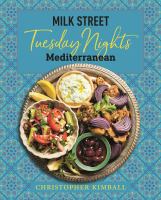
Bibliobites in March: Tepid Tuesdays
 Author and TV host Christopher Kimball and the cooks at his Milk Street empire are busy chefs indeed. In the past seven years they have published fifteen cookbooks, which has got to be some kind of record! Back in October 2021, out group reviewed Milk Street Cookish, a “quick and easy” title that delivered a fair number of hits, as well as some misses. This month we took on Milk Street Tuesday Nights Mediterranean, a 2021 title that revisits the “quick” (or is it “quickish”?) theme with a Mediterranean slant.
Author and TV host Christopher Kimball and the cooks at his Milk Street empire are busy chefs indeed. In the past seven years they have published fifteen cookbooks, which has got to be some kind of record! Back in October 2021, out group reviewed Milk Street Cookish, a “quick and easy” title that delivered a fair number of hits, as well as some misses. This month we took on Milk Street Tuesday Nights Mediterranean, a 2021 title that revisits the “quick” (or is it “quickish”?) theme with a Mediterranean slant.
To start with, our group wondered how author Kimball has managed to produce what amounts to an average of two full-length cookbooks per year. The answer was as obvious as the title page, which lists two writers and editors, three named cooks, and a group of unnamed “cooks at Milk Street.” Kimball is the author of record, but it’s unclear how much he’s involved in actual recipe development and testing. However he has a reputation for being very persnickety, and that was obvious in at least the design of the book. There are lush, detailed photos of every dish on the page facing the recipe. This made for an easy and very pleasant reading experience, as well as being useful during cooking. Even better, each recipe fit on one page, a marvelous feat that was also somehow accomplished without the font being excessively small. Well done! However, many in the group did not like how the recipes were arranged: the first three chapters are grouped by timing (fast-faster-fastest); subsequent chapters are by food type (salads, soups, vegetarian, and so on). It was an odd set of choices and made for lots of annoying flipping.
When we settled down to cooking (and there was lots of it!), the results were mixed. This is a title focused squarely on main dishes, so there were no snacks or desserts to distract us from our dinnertime quest. At our meeting, we sampled 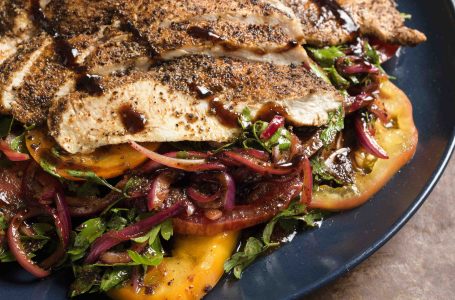 sumac-spiced chicken cutlets with tomato-onion salad. This tasty combination showcased smoked paprika and tart sumac; the tomato-onion salad provided freshness and crunch. This dish is good hot or cold and travels well, making it a solid choice for a potluck or picnic. We tried several other chicken dishes; chicken shawarma had “lots of spices to mix…I got a little frantic!” But all was forgiven since the “chicken was very tender, even when left over.” Traditional yogurt/tahini sauce was the perfect accompaniment. Another classic, chicken souvlaki with tzatziki turned out to be “a keeper….great combination, loved the tzatziki.” To keep things simple, the meat wasn’t skewered and grilled but simply broiled. Greek chicken and potato traybake was also “easy….really good.” Lemon, garlic, and kalamata olives hit all the right Mediterranean notes. Pan-roasted chicken and summer vegetables with herbes de provence saved a cook in a hurry. Ignoring all directions “I threw everything in the pot….it worked out beautifully!” Now that’s a keeper if ever there was one! There was one dud in the poultry patch: lombardy-style rice with chicken, a risotto-like dish, was “meh…bland.” The flavors were just a bit too subtle and didn’t come across in the finished dish.
sumac-spiced chicken cutlets with tomato-onion salad. This tasty combination showcased smoked paprika and tart sumac; the tomato-onion salad provided freshness and crunch. This dish is good hot or cold and travels well, making it a solid choice for a potluck or picnic. We tried several other chicken dishes; chicken shawarma had “lots of spices to mix…I got a little frantic!” But all was forgiven since the “chicken was very tender, even when left over.” Traditional yogurt/tahini sauce was the perfect accompaniment. Another classic, chicken souvlaki with tzatziki turned out to be “a keeper….great combination, loved the tzatziki.” To keep things simple, the meat wasn’t skewered and grilled but simply broiled. Greek chicken and potato traybake was also “easy….really good.” Lemon, garlic, and kalamata olives hit all the right Mediterranean notes. Pan-roasted chicken and summer vegetables with herbes de provence saved a cook in a hurry. Ignoring all directions “I threw everything in the pot….it worked out beautifully!” Now that’s a keeper if ever there was one! There was one dud in the poultry patch: lombardy-style rice with chicken, a risotto-like dish, was “meh…bland.” The flavors were just a bit too subtle and didn’t come across in the finished dish.
Quick-cooking shrimp got a workout in this book; two people made shrimp with orzo, tomatoes, and feta. This version of the classic was “really fast….really easy….flavors melded well!” Venetian-style shrimp in tomato-white wine sauce also featured tomatoes in a spicy sauce; the result was “really good” and was predictably quick to make. 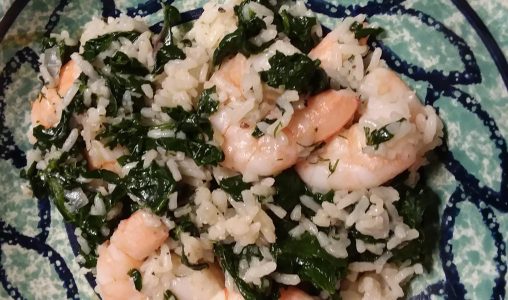 Greek-style spinach rice with shrimp and dill turned a side into a main dish with the addition of shrimp, which was gently steamed atop the cooked rice and spinach. Lemon and dill played nicely together with the spinach; it aged well, too. Two cooks tried spanish shrimp and chickpea stew. Though butterflying the cooked shrimp (as directed) proved messy and tricky, the result was “delicious!” Or “meh,” if you’re a cook who’s not very fond of smoked paprika, a prominent flavor in the stew. Unfortunately, spanish scrambled eggs with shrimp and asparagus was a thumbs-down; “the flavors were just OK….it didn’t come together….I won’t make again.”
Greek-style spinach rice with shrimp and dill turned a side into a main dish with the addition of shrimp, which was gently steamed atop the cooked rice and spinach. Lemon and dill played nicely together with the spinach; it aged well, too. Two cooks tried spanish shrimp and chickpea stew. Though butterflying the cooked shrimp (as directed) proved messy and tricky, the result was “delicious!” Or “meh,” if you’re a cook who’s not very fond of smoked paprika, a prominent flavor in the stew. Unfortunately, spanish scrambled eggs with shrimp and asparagus was a thumbs-down; “the flavors were just OK….it didn’t come together….I won’t make again.”
Another favorite for speedy meals, pasta, also made several appearances. Crispy pasta with chickpeas, lemon, and parsley was quite a twist on your standard boiled noodles: half of the uncooked fresh pasta was fried until crisp, and then added to the rest of the ingredients (including the cooked portion of the pasta) at the end. This was “kind of strange….the pasta wasn’t crispy [by the time the dish was complete].” Also, it “took a lot longer than [the stated] 35 minutes.” One saving grace: “better the second day….flavors developed.” Much more traditional, fettucine with mushroom and tomato ragu was unfortunately “disappointing….tasteless.” Despite lots of mushrooms and fresh rosemary, the flavors just didn’t come through. On the opposite side, 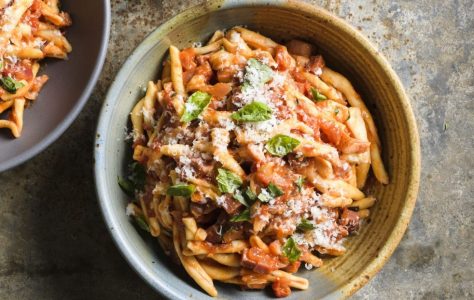 penne alla silana, although a bit on the pricey side with its plentiful salami and cheese, was enjoyably loaded with salty and spicy flavors. Pasta with tomatoes, orange, and olives featured a combination that is common in Sicily but unusual to us; and our cook ultimately did not like this marriage of fruity and salty. Another unfamiliar combination fared a bit better; rigatoni with pistachio, ricotta and herb pesto suffered from a lack of fresh basil (not very available at this time of year), but “we did eat it!” Worth trying again in the summer?
penne alla silana, although a bit on the pricey side with its plentiful salami and cheese, was enjoyably loaded with salty and spicy flavors. Pasta with tomatoes, orange, and olives featured a combination that is common in Sicily but unusual to us; and our cook ultimately did not like this marriage of fruity and salty. Another unfamiliar combination fared a bit better; rigatoni with pistachio, ricotta and herb pesto suffered from a lack of fresh basil (not very available at this time of year), but “we did eat it!” Worth trying again in the summer?
Vegetarians had plenty of choices in this book; there’s even a dedicated “hearty vegetarian” chapter.
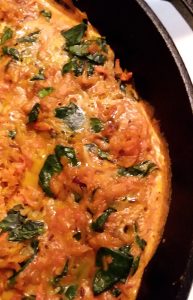
Eggah was a fluffy, tender variation on a frittata. This version was filled with grated sweet potato and carrot, onion, and spinach. For one cook it was just OK, but for another it was a definite keeper, “quick…savory…loved the texture!” Greek baked vegetables were another keeper; layered potatoes, zucchini, and tomatoes were roasted and topped with savory, salty feta. The classic flavors worked together beautifully for a delicious result. Roasted butternut squash with chickpeas, herbs, and tahini was “a bit of work” to put together, but the resulting dish was “very flavorful!” Chickpeas and tahini sauce turned roasted squash into a filling, yet not heavy, main dish. Another dish featuring butternut squash, turkish-style stuffed flatbreads with butternut squash and cheese was also a hit; mashed squash, halloumi cheese, and warm spices were rolled into flour tortillas and then shallow -fried until crispy. Yogurt/olive oil sauce provided a cooling contrast, “just a yummy combination!” Three people tried out
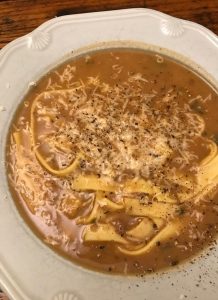 italian bean soup with fresh pasta. For two cooks it was a keeper; this very simple combination of beans, rosemary, and pasta just hit the spot. For the third cook, it may have been just a bit too simple; it was deemed “OK.” Perhaps in an attempt to keep things quick and easy, the recipe instructed you to use fresh pasta and cook it in the pureed soup. Though it’s another step, we thought it would ultimately be simpler to cook dried pasta separately and then add it to the bowls when served. A couple of lentil dishes didn’t quite make the grade: lemony lentil-kale soup with sweet potatoes had “lots of chopping,” and was “a bit too lemony…OK….wouldn’t make again.” As is often the case with lentils, the finished soup was “visually unappealing.” Poor lentils! Lentils and bulgur with fried onions (mujaddara), a popular comfort food across the Middle East, did not turn out as expected; it was “so dry….I won’t make again.” Other group members mentioned that they had made other versions of this dish and thought it was excellent, so perhaps this particular recipe isn’t the one to go with! We only made one salad, but it was a keeper: bulgur salad with summer vegetables and pomegranate molasses was “absolutely delicious!” It went to a potluck where it disappeared quickly. Pomegranate molasses added addictive fruity tartness to the dressing.
italian bean soup with fresh pasta. For two cooks it was a keeper; this very simple combination of beans, rosemary, and pasta just hit the spot. For the third cook, it may have been just a bit too simple; it was deemed “OK.” Perhaps in an attempt to keep things quick and easy, the recipe instructed you to use fresh pasta and cook it in the pureed soup. Though it’s another step, we thought it would ultimately be simpler to cook dried pasta separately and then add it to the bowls when served. A couple of lentil dishes didn’t quite make the grade: lemony lentil-kale soup with sweet potatoes had “lots of chopping,” and was “a bit too lemony…OK….wouldn’t make again.” As is often the case with lentils, the finished soup was “visually unappealing.” Poor lentils! Lentils and bulgur with fried onions (mujaddara), a popular comfort food across the Middle East, did not turn out as expected; it was “so dry….I won’t make again.” Other group members mentioned that they had made other versions of this dish and thought it was excellent, so perhaps this particular recipe isn’t the one to go with! We only made one salad, but it was a keeper: bulgur salad with summer vegetables and pomegranate molasses was “absolutely delicious!” It went to a potluck where it disappeared quickly. Pomegranate molasses added addictive fruity tartness to the dressing.
There were a few meaty doings, as well. Four people made  beef and rice meatballs with lemon-olive oil sauce. All agreed that these oversize meatballs were delicious; the accompanying sauce was deemed “the best part.” This recipe took much longer to put together than its timing indicated; mashing the cooked rice as directed proved unexpectedly tedious and time-consuming. Greek meatballs in tomato sauce were also a good choice, with a slightly spicy sauce spiked with cinnamon. They reheated well, too. Pan-roasted pork tenderloins with apple, sherry, and smoked paprika were deemed “very very tasty!” Apples and pork are a classic combination for good reason, while sherry and smoked paprika added a bit of Spanish flair.
beef and rice meatballs with lemon-olive oil sauce. All agreed that these oversize meatballs were delicious; the accompanying sauce was deemed “the best part.” This recipe took much longer to put together than its timing indicated; mashing the cooked rice as directed proved unexpectedly tedious and time-consuming. Greek meatballs in tomato sauce were also a good choice, with a slightly spicy sauce spiked with cinnamon. They reheated well, too. Pan-roasted pork tenderloins with apple, sherry, and smoked paprika were deemed “very very tasty!” Apples and pork are a classic combination for good reason, while sherry and smoked paprika added a bit of Spanish flair.
Friends, I think it’s obvious by now that we gave this book a thorough going-over. We cooked our way through over 30 unique recipes, about 25% of the book’s total! Generally, we thought this title was a solid introduction to signature Mediterranean foods and seasonings. It may not be perfectly authentic, but it’s close enough to (literally) give you the flavor of this broad area. Though we did not appreciate the book’s arrangement, once we were done flipping back and forth most of us found a keeper or two, or a new spice or condiment to wake up our taste buds (I’m looking at you, pomegranate molasses!). Still, no one was rushing out to buy this book, and our ratings were on the tepid side: we averaged out to a 3.4 (out of a possible 5).
Please join us for our next meeting on Friday, April 26 at 11 AM in the Fireplace Room. We’ll be discussing The Golden Spoon, a thriller/mystery that’s set at a baking competition, by Jessa Maxwell. Murder, she baked? Speaking of baking, if you want to bake as well as read, you can also check out a British Baking Show title; all titles available at the main circulation desk or via curbside pickup.
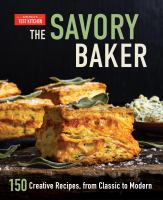
Bibliobites in February: The First Ten Years; and, No Sugar, Please!
 Yes friends, in February our Bibliobites group celebrated its first decade! In the past ten years we’ve plowed through over one hundred cookbooks, and have undoubtedly produced thousands of meals and treats in the name of rigorous review. In honor of this momentous occasion, we met for a potluck lunch, where members contributed some of their favorite dishes from past titles, as well as some new ones from our February book, The Savory Baker from America’s Test Kitchen.
Yes friends, in February our Bibliobites group celebrated its first decade! In the past ten years we’ve plowed through over one hundred cookbooks, and have undoubtedly produced thousands of meals and treats in the name of rigorous review. In honor of this momentous occasion, we met for a potluck lunch, where members contributed some of their favorite dishes from past titles, as well as some new ones from our February book, The Savory Baker from America’s Test Kitchen.
I also asked members to tell me about some of their favorite recipes and/or books from the past ten years. Though there was quite a diversity of opinions, a few titles were mentioned repeatedly. Once Upon a Chef Weeknight/Weekend produced many keepers, among them greek style shrimp with tomato and feta, drunken style noodles with shrimp, turkey, spinach, and cheese meatballs, smoky chickpea, red lentil, and vegetable soup, lasagna soup, and the universally acclaimed french apple cake. The trendy sheet pan got some Bibliobites love with Sheet Pan Suppers; top picks included roasted sausage and red grapes with polenta and gorgonzola, quick chicken and baby broccoli with spicy peanut sauce, swordfish cacciatore, chicken legs with fennel and orange, and honey-orange shrimp with baby bok choy. We’ve reviewed two of the prolific Dorie Greenspan’s books, Everyday Dorie and Baking With Dorie; dark chocolate pudding, mushroom bacon galette, and lower east side brunch tart were particularly praised.
Several other titles generated keepers, among them Pasta Modern (soup in a sack), Dinner in French (savory gruyere and ham bread), Maangchi’s Real Korean Cooking (steamed eggplant), Grains For Every Season(broccoli, tuna, and wheat berry gratin; roasted carrot; avocado, pistachio and quinoa salad), Vietnamese Food Any Day (charred brussels sprouts), Indian-ish (malaysian ramen), Cook Like a Pro (parmesan pesto zucchini sticks), The Food You Crave (three bean chili), Dinner Just For Two (chicken parmesan meatballs), The Apple Lovers’ Cookbook (cider donut muffins), Midwest Made (buckeye bars; chocolate zucchini bread), Pastry Love (thin crispy chocolate chip cookies; double chocolate rye cookies), and any of the Smitten Kitchen titles. These and so many other cookbooks are available at the Chelmsford library. Check them out and see if you find a keeper or three!
 After our delightful and filling lunch, we discussed February’s title, The Savory Baker. When most of us think about baking we have a sweet treat in mind; but with this book we put away the sugar and focused on the savory side of things. There were plenty of successes; dill feta zucchini bread with zucchini butter was “yum! The house smelled great!” This tender quick bread was loaded with fresh veggie flavors and was easy to put together. Gochujang and cheddar pinwheels were a “great combination” of crispy, buttery puff pastry and swirls of spicy gochujang paste. Though the pinwheels were addictively delicious, they unfortunately didn’t travel well, so eat them soon after you make them! Broccoli cheese cornbread was, as advertised “very moist.” The classic broccoli/cheddar combo was tasty, “I would make again.” Also in the cornmeal department,
After our delightful and filling lunch, we discussed February’s title, The Savory Baker. When most of us think about baking we have a sweet treat in mind; but with this book we put away the sugar and focused on the savory side of things. There were plenty of successes; dill feta zucchini bread with zucchini butter was “yum! The house smelled great!” This tender quick bread was loaded with fresh veggie flavors and was easy to put together. Gochujang and cheddar pinwheels were a “great combination” of crispy, buttery puff pastry and swirls of spicy gochujang paste. Though the pinwheels were addictively delicious, they unfortunately didn’t travel well, so eat them soon after you make them! Broccoli cheese cornbread was, as advertised “very moist.” The classic broccoli/cheddar combo was tasty, “I would make again.” Also in the cornmeal department,  corn muffins with cheddar and scallions were an elevated take on the standard corn muffin. Cooking a portion of the cornmeal in milk to make a “porridge” made for moist, less-gritty muffins that kept well. Cheddar and scallions added welcome assertive flavor.
corn muffins with cheddar and scallions were an elevated take on the standard corn muffin. Cooking a portion of the cornmeal in milk to make a “porridge” made for moist, less-gritty muffins that kept well. Cheddar and scallions added welcome assertive flavor.
We baked our way through lots of main dishes: two people tried  chicken pot pie with savory crumble topping. As many casseroles are, this one was “lots of work” to put together. The crumble topping turned out to be the star of the show, with its hits of Parmesan and black pepper. The filling was classic comfort food, with plenty of tender chicken, peas, and carrots; mushrooms added depth. It’s a worthwhile project, especially if you need to feed a crowd. Vegetable pot pie was also a winner, and also a bit of a project. The filling featured mushrooms, chard, and turnips (“I loved the turnips!”) for a hearty, yet light main dish.
chicken pot pie with savory crumble topping. As many casseroles are, this one was “lots of work” to put together. The crumble topping turned out to be the star of the show, with its hits of Parmesan and black pepper. The filling was classic comfort food, with plenty of tender chicken, peas, and carrots; mushrooms added depth. It’s a worthwhile project, especially if you need to feed a crowd. Vegetable pot pie was also a winner, and also a bit of a project. The filling featured mushrooms, chard, and turnips (“I loved the turnips!”) for a hearty, yet light main dish.  Butternut squash galette with gruyere was a satisfying combination of nutty, flaky, whole wheat pastry, sweet squash, and mellow gruyere. It reheated well, too, “a keeper!” A more springlike tart, asparagus and goat cheese tart, was easy to put together with store-bought puff pastry and tender thin asparagus. Goat cheese added just the right accent to this French-inspired tart. Cheese pupusas (“I made chicken”) were just plain “fabulous!” These filled corn griddle cakes were a bit fussy to assemble, though the “pie plate technique” detailed in the recipe made it easier.
Butternut squash galette with gruyere was a satisfying combination of nutty, flaky, whole wheat pastry, sweet squash, and mellow gruyere. It reheated well, too, “a keeper!” A more springlike tart, asparagus and goat cheese tart, was easy to put together with store-bought puff pastry and tender thin asparagus. Goat cheese added just the right accent to this French-inspired tart. Cheese pupusas (“I made chicken”) were just plain “fabulous!” These filled corn griddle cakes were a bit fussy to assemble, though the “pie plate technique” detailed in the recipe made it easier.
In the yeasted department, 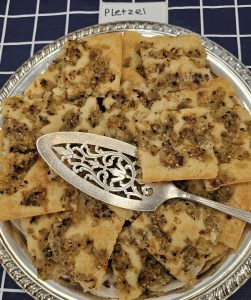 pletzel was so good, “I made it twice!” This thin, super-light foccaccia cousin featured lots of sweet sauteed onions and everything bagel seasoning (“I couldn’t find poppy seeds!”). It’s a great go-with for soups, or on its own as a snack. Thin crust pizza with pumpkin, cashew ricotta, and apple-fennel slaw was something of a project (as well as a mouthful to say!). The ridiculously simple slaw was “the best part” and worth making on its own. According to the recipe, the dough was supposedly easy to stretch, but it was frustratingly prone to snapping back, and required lots of time and patience to roll out thinly.
pletzel was so good, “I made it twice!” This thin, super-light foccaccia cousin featured lots of sweet sauteed onions and everything bagel seasoning (“I couldn’t find poppy seeds!”). It’s a great go-with for soups, or on its own as a snack. Thin crust pizza with pumpkin, cashew ricotta, and apple-fennel slaw was something of a project (as well as a mouthful to say!). The ridiculously simple slaw was “the best part” and worth making on its own. According to the recipe, the dough was supposedly easy to stretch, but it was frustratingly prone to snapping back, and required lots of time and patience to roll out thinly.
For our (mostly non-baking) group, the savory aspect of this book made it more enjoyable than your average baking book. It was fun to take your typical scone or muffin and have the flavors go sideways. And many of the categories, like tarts and pot pies, made for delicious cozy winter dinners. We also loved the fantastic and copious photos. There are pictures of almost every recipe, as well as some photo sequences illustrating a particular technique. FYI the print is pretty small, but at least it was a sharp black that made it easier to read than the now-prevalent gray. Our rating for this title averaged out to a 3.5 (out of a possible 5), a vote of confidence from this group!
Please join us at our next meeting on Friday, March 22 at 11 AM in the Fireplace Room. We’ll be ushering in our next decade with Christopher Kimball’s Milk Street Tuesday Nights Mediterranean. Copies are available at the main circulation desk or via curbside pickup. See you there!
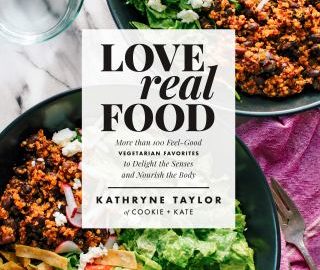
Bibliobites in January: Vegetarian Everywhere All at Once
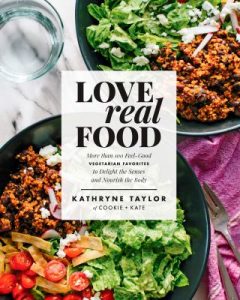 It’s the season of hunkering. Whether because of rain, snow, gloom, or depressingly early sunsets, January is a time when many of us stick close to home. And what better way to spend a chilly day than snuggled up to your stove with a good cookbook? This month our Bibliobites crew chased the winter blues away with blogger Kathryne Taylor’s Love Real Food. This 2016 title is a comprehensive survey of contemporary vegetarian food from breakfast through cocktails, dinner, and dessert. After the excesses of December, many of us are more than ready to up our veggie quotient and focus on an “everyday” style of cooking.
It’s the season of hunkering. Whether because of rain, snow, gloom, or depressingly early sunsets, January is a time when many of us stick close to home. And what better way to spend a chilly day than snuggled up to your stove with a good cookbook? This month our Bibliobites crew chased the winter blues away with blogger Kathryne Taylor’s Love Real Food. This 2016 title is a comprehensive survey of contemporary vegetarian food from breakfast through cocktails, dinner, and dessert. After the excesses of December, many of us are more than ready to up our veggie quotient and focus on an “everyday” style of cooking.
Since it was a rather wet and gloomy month, indoor pursuits were definitely on the table (so to speak!). So there was an impressive amount of recipe-testing going on. Let’s start with a few breakfast treats: simple honey scones were “really easy,” but were not appealing; they were “gummy….dry….not enough sweetener.” We sampled these at our meeting and agreed that they were disappointing, though the wheaty flavor was nicely hearty. My favorite granola also didn’t quite make the grade; it “needs more of everything [cinnamon, cranberries].” However, “I liked that it wasn’t super-sweet.”  Carrot cake breakfast cookies fared better; these were “pretty tasty” with plenty of grated carrots, pecans, and golden raisins. If you live in a small household, you’ll appreciate that these make a small batch. And sneaking in through the dessert department, lemony almond-blueberry cake was “not lemony enough” for some. We tasted this treat at our meeting and some thought the lemon flavor was just right, while others wished for more. This cake is gluten free; it’s made with almond meal which gave the cake a welcome hint of almond flavor.
Carrot cake breakfast cookies fared better; these were “pretty tasty” with plenty of grated carrots, pecans, and golden raisins. If you live in a small household, you’ll appreciate that these make a small batch. And sneaking in through the dessert department, lemony almond-blueberry cake was “not lemony enough” for some. We tasted this treat at our meeting and some thought the lemon flavor was just right, while others wished for more. This cake is gluten free; it’s made with almond meal which gave the cake a welcome hint of almond flavor.
Main dishes provided plenty of variety, always a plus when you’re wondering what to make for dinner. Traditional quiche got a bit of an upgrade with  spinach-artichoke quiche, its filling a riff on the popular dip, and a pat-in crust made with almond meal accented with thyme and garlic. It could have used more spinach in the filling, but overall this dish was a winner. It reheated well, too. Roasted eggplant lasagna was, unsurprisingly, “a project.” This was deemed “good” but not great. The sauce was basically pureed tomatoes and might have benefited from some simmering, and the called-for whole wheat no-boil noodles proved difficult to find. Sun-dried tomato fettucine alfredo with spinach also featured whole wheat pasta, but fettucine was was easy enough to find. The alfredo sauce used the common vegan trick of pureeing soaked cashews to make a creamy sauce, which in this case worked really well. Though not a traditional version, it was an enjoyable riff on the classic, with garlic, spinach, and sun-dried tomatoes amping up the flavor profile. Three people made roasted broccoli, bell pepper, and tofu bowl with peanut sauce; it proved to be an unexpected keeper. The baked tofu was “great!” and the peanut sauce enjoyably “assertive.” Those who tried it all agreed it was a new favorite. There’s a similar recipe on the author’s blog using brussels sprouts instead of broccoli. Check it out!
spinach-artichoke quiche, its filling a riff on the popular dip, and a pat-in crust made with almond meal accented with thyme and garlic. It could have used more spinach in the filling, but overall this dish was a winner. It reheated well, too. Roasted eggplant lasagna was, unsurprisingly, “a project.” This was deemed “good” but not great. The sauce was basically pureed tomatoes and might have benefited from some simmering, and the called-for whole wheat no-boil noodles proved difficult to find. Sun-dried tomato fettucine alfredo with spinach also featured whole wheat pasta, but fettucine was was easy enough to find. The alfredo sauce used the common vegan trick of pureeing soaked cashews to make a creamy sauce, which in this case worked really well. Though not a traditional version, it was an enjoyable riff on the classic, with garlic, spinach, and sun-dried tomatoes amping up the flavor profile. Three people made roasted broccoli, bell pepper, and tofu bowl with peanut sauce; it proved to be an unexpected keeper. The baked tofu was “great!” and the peanut sauce enjoyably “assertive.” Those who tried it all agreed it was a new favorite. There’s a similar recipe on the author’s blog using brussels sprouts instead of broccoli. Check it out!
Winter is peak soup and stew season, and most in our group made good use of this category. Three people tried tuscan white bean, kale, and farro stew a hearty melange that hit the spot. Classic flavors included the white beans, plenty of fresh rosemary, and Parmesan. This made a large potful so fortunately it aged well. Butternut squash chipotle chili was also a hit, with its smoky chipotles and sweet squash. The combination was “really good….will make again!” Moroccan butternut, chickpea, and couscous stew had some nice assertive spicing with smoked paprika and curry powder; the result was “good” but not great. Whole wheat couscous was another ingredient that was difficult to find, and our cook substituted pearl couscous; unfortunately “I didn’t like the texture.” Two people made 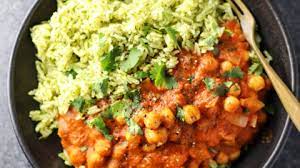 chickpea tikka masala with green rice; both thought it was a solid, if not outstanding version of this iconic dish. The green rice was a bit fussy to make and didn’t seem to add much to the overall flavor, so feel free to skip it.
chickpea tikka masala with green rice; both thought it was a solid, if not outstanding version of this iconic dish. The green rice was a bit fussy to make and didn’t seem to add much to the overall flavor, so feel free to skip it.
If you want to slurp some soup, perhaps start with classic tomato soup. This version used some pureed beans to thicken the soup and make it into more of a meal; “I really liked this!” Creamy roasted cauliflower soup didn’t fare as well; it was “very beige” and was “OK…a lot of work.” But, the crouton topper was “great!” Heartier choices included west african peanut soup which four people tried and was “good- especially with the hot sauce” though “I have other, similar recipes.” 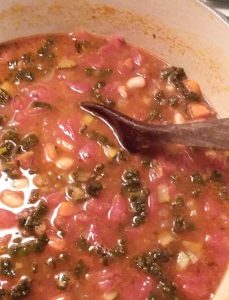 Hearty lentil minestrone was likewise a solid, if not outstanding choice. The addition of lentils didn’t add much to the otherwise classic recipe. Black bean tortilla soup with sweet potatoes turned out to be a keeper, “I really liked….substantial….will make again!” The black beans and sweet potatoes added heft to a recipe that typically includes chicken.
Hearty lentil minestrone was likewise a solid, if not outstanding choice. The addition of lentils didn’t add much to the otherwise classic recipe. Black bean tortilla soup with sweet potatoes turned out to be a keeper, “I really liked….substantial….will make again!” The black beans and sweet potatoes added heft to a recipe that typically includes chicken.
There were lots more main dishes to try; sweet potato, poblano, and black bean enchiladas were a California-ish version with creamy avocados and cheese. These were a solid choice with one caveat, ” they didn’t keep that well.” Unfortunately, coconut fried rice with edamame was disappointing; it had “no flavor….needed more spice….couldn’t taste the coconut.” But, kale and quinoa salad with crisp celery, plumped cranberries, and lemon dressing was an “absolutely yummy” (if very wordy) salad. This was a warm salad, “so delicious” with its mustardy lemon dressing. A keeper! Though technically a side dish, moroccan roasted carrot, arugula and wild rice salad was substantial enough for a light main dish. Two cooks praised the seasoning (chili and cinnamon) and the lemony dressing, though “it needed more dressing.” Plus, the roasted carrots were perfect just by themselves, should you not want to deal with the other salad ingredients. Those of us who sampled this at our meeting had to agree that it was a hit. To go with those carrots, you might make sweet potato-black bean veggie burgers. These were a good version of veggie burgers, if a bit of a project. Quick cooking oats in the burger mix were an inspired choice to provide some chew and bind the ingredients together. Or, maybe you’d like to have some pizza with a base of  easiest honey whole wheat pizza dough. This dough was super-quick and easy to make, and had the additional virtue of no waiting/rising time. A keeper!
easiest honey whole wheat pizza dough. This dough was super-quick and easy to make, and had the additional virtue of no waiting/rising time. A keeper!
As should be obvious by now, we gave this title a thorough workout. Though there was nothing shockingly innovative, most people enjoyed the variety and accessibility of the recipes, and a few were pleasantly surprised at how much they enjoyed their trip to veggie land. We did note that there were a few too many dishes that relied on black beans, sweet potatoes, butternut squash, and kale. The author also uses a fair amount of coconut oil, which has both passionate advocates and detractors. As for the book itself, it’s fairly typical of its ilk, with a large-ish format and copious photos. Since it’s written by a blogger, there are also somewhat lengthy headnotes and numerous photos of the author and her adorable dog, Cookie. No one complained about these quirks; undoubtedly they were focused on the food! As mentioned, there was overall a positive response to this book, which was reflected in our rating of 3.45 (out of a possible 5). Most people rated it a 4.
Join us for our next meeting on Sunday February 25 at 1 PM (note different day and time!) We’ll be discussing The Savory Baker from America’s Test Kitchen. We’ll also be celebrating ten years of Bibliobites with a look back at some of our previous titles, and a potluck lunch. Hope to see you there!
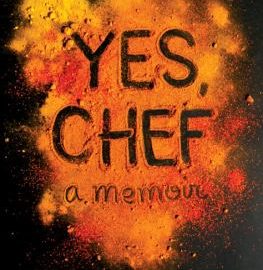
Bibliobites in November/December: Chasing Flavors
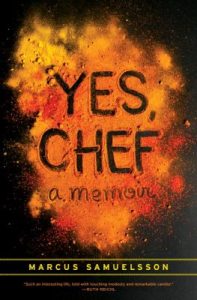 Unrelenting drive. Fierce determination. Boundless energy and ambition. Obsessive single-mindedness. Plus a dollop of anxiety. Put all these traits together and you have a recipe for what it takes to become a successful chef in the hyper-competitive world of fine dining. In addition to the above qualities, many of today’s cooking stars have unusual backgrounds and compelling life stories, none more so than Marcus Samuelsson, author of this month’s title, the classic memoir Yes, Chef. An Ethiopian by birth, he was adopted by a Swedish family at the age of three, trained in restaurants all over Europe as a teenager, and ultimately settled in New York City, where he owns multiple restaurants. He’s a James Beard award winner and is also a fixture on TV, having appeared on (and won) Top Chef Masters, and is currently the host of PBS’ No Passport Required. As is always the case with a memoir, the reader wants to know why and how someone arrived at where they are today. The steps may be convoluted, but often the goal is straightforward, and in this Samuelsson is no exception.
Unrelenting drive. Fierce determination. Boundless energy and ambition. Obsessive single-mindedness. Plus a dollop of anxiety. Put all these traits together and you have a recipe for what it takes to become a successful chef in the hyper-competitive world of fine dining. In addition to the above qualities, many of today’s cooking stars have unusual backgrounds and compelling life stories, none more so than Marcus Samuelsson, author of this month’s title, the classic memoir Yes, Chef. An Ethiopian by birth, he was adopted by a Swedish family at the age of three, trained in restaurants all over Europe as a teenager, and ultimately settled in New York City, where he owns multiple restaurants. He’s a James Beard award winner and is also a fixture on TV, having appeared on (and won) Top Chef Masters, and is currently the host of PBS’ No Passport Required. As is always the case with a memoir, the reader wants to know why and how someone arrived at where they are today. The steps may be convoluted, but often the goal is straightforward, and in this Samuelsson is no exception.
Samuelsson’s journey could be described with so many superlative adjectives that it’s hard to know where to start. Born during a severe famine in Ethiopia, it’s astonishing that he survived at all. Culturally, he grew up Swedish in his adoptive family, and fell in love with cooking during the innumerable Sunday afternoons he spent helping his grandmother prepare family dinner. Though he enjoyed being in the kitchen, his first love was soccer, and he devoted endless hours to perfecting his game, with the goal of playing on a professional level. When that door closed, he turned his considerable work ethic towards cooking. Once again, we read about the exhaustion and exhilaration of kitchen life: the drudgery of starting at the bottom (spending hours cleaning a walk-in refrigerator); the fear of making a career-ending mistake; the thrill of being on the line and creating original dishes. We wondered, as we have before, why kitchen culture is so intense and unforgiving. It’s anxiety-inducing to read about, let alone live through. Several opinions came to mind, among them the theory of a self-selecting population: the field often seems to attract adrenaline junkies and risk-takers. Sometimes a class system is at play, too; many enter the field at the bottom, as dishwashers or low-level prep workers, and claw their way through a Darwinian system without benefit of unattainable, expensive culinary training.
 Though Samuelsson trained in multiple European countries, he had ambitions beyond traditional fine-dining restaurants. His culinary quest, as he repeatedly says, is about “chasing flavors,” and his desire to meld the many culinary influences in his life: African, Swedish, and ultimately, that of the Black community in the US. Samuelsson moved to New York City as a young man and immediately embraced the city’s diversity, and his quest for flavors expanded beyond anything he had once envisioned. Ultimately he opened the Red Rooster restaurant in Harlem, in which he’s been able to express all the aspects of his life and training through unique, and yet familiar, food.
Though Samuelsson trained in multiple European countries, he had ambitions beyond traditional fine-dining restaurants. His culinary quest, as he repeatedly says, is about “chasing flavors,” and his desire to meld the many culinary influences in his life: African, Swedish, and ultimately, that of the Black community in the US. Samuelsson moved to New York City as a young man and immediately embraced the city’s diversity, and his quest for flavors expanded beyond anything he had once envisioned. Ultimately he opened the Red Rooster restaurant in Harlem, in which he’s been able to express all the aspects of his life and training through unique, and yet familiar, food.
There actually weren’t an overwhelming number of comments about this title. Many of us already knew his story, but it’s likely that we were all simply stunned into silence by his incredible persistence and ultimate success. As one person put it, “what a remarkable life!” Though it’s obvious from the memoir that Samuelsson isn’t a perfect human being, you can’t help but cheer his achievements and applaud his triumphs. Our feelings were reflected in our rating: a stellar 4.25 out of a possible 5.
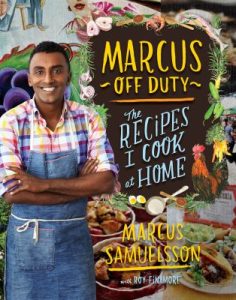 In addition to the memoir, we perused one of Samuelsson’s cookbooks, 2014’s Marcus Off Duty: The Recipes I Cook at Home. Even if you didn’t cook from this book, it’s a fun read. There are colorful and inviting photos of almost every recipe, and of the author’s Harlem neighborhood. Chapter headings feature a playlist of songs for you to enjoy while in the kitchen, all penned in a charming, “handwritten” font. But, what did we make while humming along?? One thing we discovered pretty quickly: when Marcus cooks at home, he has a lot more ingredients at the ready than we do! And, unsurprisingly for a chef, he doesn’t mind a bit of prep. Unfortunately, one of the simpler recipes in the book, quinoa with broccoli, cauliflower, and toasted coconut didn’t quite make the grade. Three people tried this, and all used the word “bland” to describe it. And, also unfortunately in this case, it made quite a bit and we struggled to finish it off.
In addition to the memoir, we perused one of Samuelsson’s cookbooks, 2014’s Marcus Off Duty: The Recipes I Cook at Home. Even if you didn’t cook from this book, it’s a fun read. There are colorful and inviting photos of almost every recipe, and of the author’s Harlem neighborhood. Chapter headings feature a playlist of songs for you to enjoy while in the kitchen, all penned in a charming, “handwritten” font. But, what did we make while humming along?? One thing we discovered pretty quickly: when Marcus cooks at home, he has a lot more ingredients at the ready than we do! And, unsurprisingly for a chef, he doesn’t mind a bit of prep. Unfortunately, one of the simpler recipes in the book, quinoa with broccoli, cauliflower, and toasted coconut didn’t quite make the grade. Three people tried this, and all used the word “bland” to describe it. And, also unfortunately in this case, it made quite a bit and we struggled to finish it off. 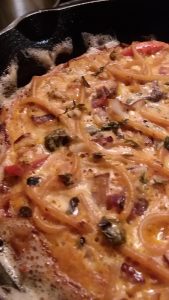 The-day-after pasta frittata fared somewhat better; two people made this. For one person it “wasn’t bad,” but for another this simple dish hit the spot. You did have to have already-cooked pasta with sauce on hand, which is great if you have that, and another step if you don’t. Still, it was a nice take on leftover pasta.
The-day-after pasta frittata fared somewhat better; two people made this. For one person it “wasn’t bad,” but for another this simple dish hit the spot. You did have to have already-cooked pasta with sauce on hand, which is great if you have that, and another step if you don’t. Still, it was a nice take on leftover pasta.
There were other main-dish hits as well: k-town noodles were “really good” with strong umami notes from kimchi, soy sauce, and sesame oil. 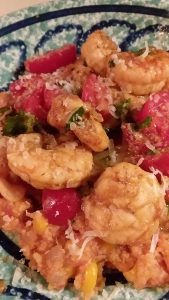 Red shrimp and spicy grits was a solid take on this classic (and popular) dish, though “I still wished the grits had cheese in them!” Orange-curry beef stir-fry with broccolini had “nice flavors” but was somewhat downgraded because it had “lots of ingredients [to prep].” Continuing with the Asian theme, peanut noodles with slaw were either “dry and gluey” or had “the best, most addictive peanut sauce I’ve made,” depending on who you talked to! A nod to Samuelsson’s Swedish upbringing, helga’s meatballs and gravy with carrot-apple mashed potatoes showed that grandmother really may know best; the meatballs were “great– moist and tender,” though the traditional cream gravy was a bit bland. The recipe’s headnote tells us that the author added carrot and apple to the mashed potatoes, but the result was “not worth the effort.” And firehouse stovetop clambake was a twist on a very traditional American dish; this was “really good” with the typical ingredients of shellfish, potatoes, and onions. Making it on the stove turned it into a nice wintertime treat.
Red shrimp and spicy grits was a solid take on this classic (and popular) dish, though “I still wished the grits had cheese in them!” Orange-curry beef stir-fry with broccolini had “nice flavors” but was somewhat downgraded because it had “lots of ingredients [to prep].” Continuing with the Asian theme, peanut noodles with slaw were either “dry and gluey” or had “the best, most addictive peanut sauce I’ve made,” depending on who you talked to! A nod to Samuelsson’s Swedish upbringing, helga’s meatballs and gravy with carrot-apple mashed potatoes showed that grandmother really may know best; the meatballs were “great– moist and tender,” though the traditional cream gravy was a bit bland. The recipe’s headnote tells us that the author added carrot and apple to the mashed potatoes, but the result was “not worth the effort.” And firehouse stovetop clambake was a twist on a very traditional American dish; this was “really good” with the typical ingredients of shellfish, potatoes, and onions. Making it on the stove turned it into a nice wintertime treat.
We tried some sides and snacks, too. Pickled tomato soup with corn bread croutons was “terrible– the vinegar overpowered everything.” That would be the half cup of cider vinegar in a smallish batch of soup. However, the market-fresh corn bread was a hit for both people who made it; buttermilk, cheddar cheese, scallions, and spices made for an extremely flavorful loaf. It kept well, too.  Aunt josulyn’s roti was a chickpea-stuffed flatbread that made a great snack or side for soup. These were a bit of a project, but the resulting flaky pastry and spiced filling were worth the effort. The recipe made 8 flatbreads, and leftovers reheated well. One person made coconut peanut butter, a component of sticky bacon sandwiches. We sampled this at our meeting, and all agreed that the spicing was unappealing. Cloves and nutmeg were overly dominant and produced an odd, almost medicinal effect. Not a keeper! Spiced nuts were much more successful flavor-wise, featuring the addictive sweet/salty combo. However, the spices and sugar “didn’t really coat the nuts,” which was a bit disappointing. But worth trying again.
Aunt josulyn’s roti was a chickpea-stuffed flatbread that made a great snack or side for soup. These were a bit of a project, but the resulting flaky pastry and spiced filling were worth the effort. The recipe made 8 flatbreads, and leftovers reheated well. One person made coconut peanut butter, a component of sticky bacon sandwiches. We sampled this at our meeting, and all agreed that the spicing was unappealing. Cloves and nutmeg were overly dominant and produced an odd, almost medicinal effect. Not a keeper! Spiced nuts were much more successful flavor-wise, featuring the addictive sweet/salty combo. However, the spices and sugar “didn’t really coat the nuts,” which was a bit disappointing. But worth trying again.
This title is one that, at first blush, seemed approachable and fun. However, Samuelsson’s flavors and spicing are often quite different than what we’re accustomed to, and sometimes we thought it worked incredibly well, but sometimes it didn’t. This title clearly reflects that Samuelsson has chased flavors from all over the world. Some combinations we didn’t care for might become favorites given enough exposure! Another flaw for us was the extensive ingredient lists found in many of the recipes. Especially in December, most of us are looking for uncomplicated dishes. So the fault may be in the timing of this title rather than the book itself. Whatever the reason, when it came to a vote, we averaged out to a 1.825 out of a possible 5. Ouch! Sorry Marcus! We think you’re amazing, but perhaps we’ll just hope to visit one of your restaurants someday, rather than cooking from your books at home.
Our first meeting of 2024 is coming up soon. Please join us on Friday, January 26 at 11 AM in the Fireplace Room. We’ll be discussing blogger Kathryne Taylor’s Love Real Food. Copies are still available at the main circulation desk or via curbside pickup. Give it a glance, and see you on the 26th.
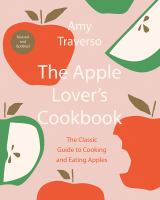
Bibliobites in October: Falling For Apples
 The jury’s still out on whether an apple a day really does keep the doctor away, but if it’s fall in New England, then it’s apples all day and every which way. Fresh or in crisp or pie, pressed into cider or cooked down into sauce, apples are endlessly versatile and uniquely delicious. This month’s title, The Apple Lover’s Cookbook by Amy Traverso, introduced us to some new ways with apples, and acquainted us with some less- common varieties that (it turns out) grow close to home.
The jury’s still out on whether an apple a day really does keep the doctor away, but if it’s fall in New England, then it’s apples all day and every which way. Fresh or in crisp or pie, pressed into cider or cooked down into sauce, apples are endlessly versatile and uniquely delicious. This month’s title, The Apple Lover’s Cookbook by Amy Traverso, introduced us to some new ways with apples, and acquainted us with some less- common varieties that (it turns out) grow close to home.
The beginning of this book features a primer (as the author calls it) of apple varieties, which was easily one of the most interesting and useful parts of the book. There are photos and descriptions of 59 apple varieties, some of which are quite common in area supermarkets, and others that we’d never seen or heard of. After reading through it, I wondered just how different in taste and texture these apples might be. 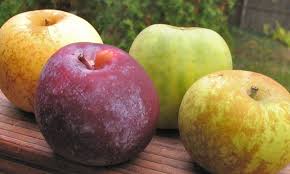 So, in the name of scientific research, I went to a local orchard and chose six heirloom varieties: Baldwin, Cox’s Orange Pippin, Jonathan, Newtown Pippin, Spencer, and Winesap. At our meeting we conducted a blind taste test, and….they all were unique! For almost all of us, Cox’s Orange Pippin was the favorite, with the Spencer a close second. Though the book’s primer lists the Pippin as a sweet apple, we thought it had plenty of tartness. Perhaps it was the balance of tart and sweet that was so appealing? The Spencer was a bit sweeter than the
So, in the name of scientific research, I went to a local orchard and chose six heirloom varieties: Baldwin, Cox’s Orange Pippin, Jonathan, Newtown Pippin, Spencer, and Winesap. At our meeting we conducted a blind taste test, and….they all were unique! For almost all of us, Cox’s Orange Pippin was the favorite, with the Spencer a close second. Though the book’s primer lists the Pippin as a sweet apple, we thought it had plenty of tartness. Perhaps it was the balance of tart and sweet that was so appealing? The Spencer was a bit sweeter than the 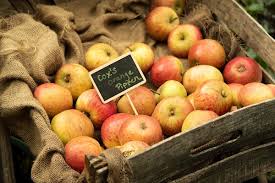 Pippin, but what we liked most about it was its satisfying crunch. Our least favorite was the Baldwin; our sample was unappealingly mushy. The primer lists this apple as a “firm-sweet,” so we can only assume it had not been recently picked. Many older apple varieties are experiencing a resurgence, so next time you’re at an orchard, check out all the possibilities. You’re sure to find a new favorite!
Pippin, but what we liked most about it was its satisfying crunch. Our least favorite was the Baldwin; our sample was unappealingly mushy. The primer lists this apple as a “firm-sweet,” so we can only assume it had not been recently picked. Many older apple varieties are experiencing a resurgence, so next time you’re at an orchard, check out all the possibilities. You’re sure to find a new favorite!
Once apple tasting was done, it was time to get down to the nitty-gritty: what did we do with all those apples? The author gave us plenty of choices, both sweet and savory. As is often the case, most of us went straight to the main dishes. Four of us made 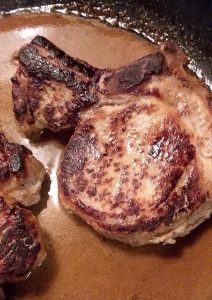 cider-brined pork chops with mustard pan sauce. The chops, brined in cider, were “very tender,” and the mustard sauce was a nice (if a bit too dominant) complement. However the whole thing “wasn’t very apple-y,” and the “flavor didn’t match the number of ingredients.” On the other hand, sausage with braised cabbage and apples had “lots of apple flavor….really good!” This hearty combination also featured caraway seeds, which are not a favorite for some! Sweet potato, apple and ginger soup was “good, but not a keeper.” This was a pleasant combination with a fairly subdued apple presence; it was similar to other soup recipes so it didn’t really stand out.
cider-brined pork chops with mustard pan sauce. The chops, brined in cider, were “very tender,” and the mustard sauce was a nice (if a bit too dominant) complement. However the whole thing “wasn’t very apple-y,” and the “flavor didn’t match the number of ingredients.” On the other hand, sausage with braised cabbage and apples had “lots of apple flavor….really good!” This hearty combination also featured caraway seeds, which are not a favorite for some! Sweet potato, apple and ginger soup was “good, but not a keeper.” This was a pleasant combination with a fairly subdued apple presence; it was similar to other soup recipes so it didn’t really stand out.
Some of the more substantial vegetable recipes could almost be main dishes: squash stuffed with apples, pancetta, and walnuts was “a keeper! Delicious!” It had beautiful layers of flavor: meaty and sweet, with a welcome sharp note from the Gorgonzola. 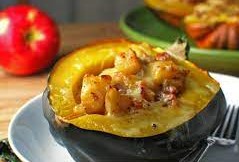 Squash and apple gratin was a bit less successful; it was just “OK.” The breadcrumb topper burned when kept under the broiler for 5 minutes, as the recipe instructed. Perhaps with less char some of the other flavors would have come through? A few other veggie dishes were big hits: cider-glazed root vegetables were “yummy….the glaze adds so much extra flavor!” And parsnip-apple puree was “not colorful but very good…the apple took away the bitter edge of the parsnips….nice balance!” And should you crave a bit of tangy, salty crunch to serve on the side, quick bread-and-butter apple pickles were a definite keeper. The combo of thinly sliced cucumber, apple, and shallot paired perfectly with the mild brine and some fresh tarragon. Easy to put together, too.
Squash and apple gratin was a bit less successful; it was just “OK.” The breadcrumb topper burned when kept under the broiler for 5 minutes, as the recipe instructed. Perhaps with less char some of the other flavors would have come through? A few other veggie dishes were big hits: cider-glazed root vegetables were “yummy….the glaze adds so much extra flavor!” And parsnip-apple puree was “not colorful but very good…the apple took away the bitter edge of the parsnips….nice balance!” And should you crave a bit of tangy, salty crunch to serve on the side, quick bread-and-butter apple pickles were a definite keeper. The combo of thinly sliced cucumber, apple, and shallot paired perfectly with the mild brine and some fresh tarragon. Easy to put together, too.
There’s a breakfast-y chapter and that appealed to many; baked apple oatmeal pudding was “pretty good….similar to others.” It was “very filling” and would be great for breakfast, or even dessert. If you’re craving a more elegant start to your day,  crepes filled with caramelized apples might suit, though “creme fraiche and maple syrup are expensive!” The crepe recipe was “fine” and it did make a lot. A more substantial breakfast option, sausage, apple, and cheddar strata was unfortunately “disappointing.” The casserole was overall too soft and “needed more body.” It’s possible that the bread used was not sturdy enough. Worth a repeat?
crepes filled with caramelized apples might suit, though “creme fraiche and maple syrup are expensive!” The crepe recipe was “fine” and it did make a lot. A more substantial breakfast option, sausage, apple, and cheddar strata was unfortunately “disappointing.” The casserole was overall too soft and “needed more body.” It’s possible that the bread used was not sturdy enough. Worth a repeat?
In the baking department, apple pumpkin walnut muffins were a hit with their classic fall flavors and spices. The recipe makes 15 standard-size muffins, so it’s a good choice for a crowd. Cider donut muffins were also a hit and did taste just like a cider donut. These baked treats were “not too sweet” and had prominent cider notes, “I would make again!” Oatmeal topped apple crisp was “demolished” at a potluck, which is as good an endorsement as any. The classic oat/nut/spice topper was a winner. Apple apricot kuchen also went to a party, where it “disappeared!” This “easy” dessert was “really good,” though it needed more bake time than the recipe indicated. 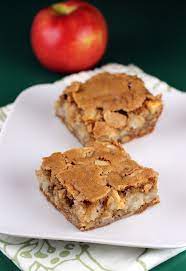 Apple brownies were also a quick and easy treat. It was “best when fresh but still good left over,” and earned keeper status. A very similar cake, simple apple nut cake was much less successful. Though it was tasty and apple-y when first baked, it turned into a wet mess after a day. The apples exuded so much moisture that the cake became an inedible sodden pudding. In comparing the brownie and cake recipes (conveniently on facing pages of the book), about the only difference is that the cake calls for 50% more apples than the brownies, which may have been the culprit. Applesauce is yet another tasty classic that will easily use up any apple surplus you may have; orange-scented spiced applesauce had a pleasing spice combo of cinnamon and cloves, though the orange flavor “wasn’t strong enough.”
Apple brownies were also a quick and easy treat. It was “best when fresh but still good left over,” and earned keeper status. A very similar cake, simple apple nut cake was much less successful. Though it was tasty and apple-y when first baked, it turned into a wet mess after a day. The apples exuded so much moisture that the cake became an inedible sodden pudding. In comparing the brownie and cake recipes (conveniently on facing pages of the book), about the only difference is that the cake calls for 50% more apples than the brownies, which may have been the culprit. Applesauce is yet another tasty classic that will easily use up any apple surplus you may have; orange-scented spiced applesauce had a pleasing spice combo of cinnamon and cloves, though the orange flavor “wasn’t strong enough.”
Most of us enjoyed this book. Though there weren’t many revelations in the recipe department (it was published in 2014), the apple information, particularly the primer, was much appreciated, and we did come away with some new ideas and a few keepers. We liked the author’s friendly and straightforward voice; in particular we liked her detailed instructions. Since this title is almost ten years old, it did not have enough photos to satisfy a 2023 reader, though the photos we had were good ones. This book has a “revised and updated” version published in 2020. It’s not much different than the original, though it does have about a dozen additional recipes and some extra photos. When it came to the votes, we averaged out to a 3.4 (out of a possible 5). That’s a pretty good score for this group, and reflects our appreciation of the author’s wide-ranging apple knowledge.
Join us at our next meeting on Friday, December 1 at 11 AM in the Fireplace Room. Please note, this is a combined November/December meeting. We’ll be discussing chef Marcus Samuelsson’s classic memoir, Yes, Chef, as well as one of his cookbooks, Marcus Off Duty: The Recipes I Cook at Home. Happy Thanksgiving to all, and see you on the 1st!
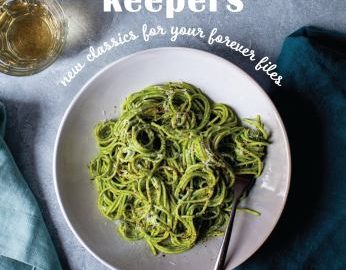
Bibliobites in September: Jeepers! Keepers?
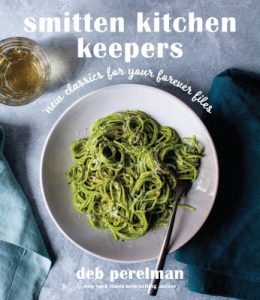 “Keeper” is a word that’s wormed its way into practically every aspect of modern life. A keeper can be a person, a thing, an idea, or….a recipe! The quest for these sometimes-elusive keepers has us plowing through all manner of cookbooks; but, one may reasonably ask, what constitutes a keeper? After all, a keeper is an extremely personal thing. One cook may value taste above all else, another ease of preparation, or only one pot to wash, or a fit with dietary restrictions, or…..! We could go on all day. But, some brave authors are willing to wade into these murky waters and claim to provide us with a whole book of keepers, which brings us to September’s book, ace blogger Deb Perelman’s latest, Smitten Kitchen Keepers: New Classics For Your Forever Files. With a title like that, the gauntlet (or the oven mitt?) was definitely thrown down, and our intrepid cooks were ready to pick it up and wrestle with it in the kitchen.
“Keeper” is a word that’s wormed its way into practically every aspect of modern life. A keeper can be a person, a thing, an idea, or….a recipe! The quest for these sometimes-elusive keepers has us plowing through all manner of cookbooks; but, one may reasonably ask, what constitutes a keeper? After all, a keeper is an extremely personal thing. One cook may value taste above all else, another ease of preparation, or only one pot to wash, or a fit with dietary restrictions, or…..! We could go on all day. But, some brave authors are willing to wade into these murky waters and claim to provide us with a whole book of keepers, which brings us to September’s book, ace blogger Deb Perelman’s latest, Smitten Kitchen Keepers: New Classics For Your Forever Files. With a title like that, the gauntlet (or the oven mitt?) was definitely thrown down, and our intrepid cooks were ready to pick it up and wrestle with it in the kitchen.
Our group has been in Smitten territory before; this is the author’s third cookbook and we’ve reviewed them all! Visually, this new one matches the others (if you are a fan, they will all sit nicely together on your shelf), with the typical large format and admirable photography, shot by the author. As a blogger Ms. Perelman does love her headnotes, and some in our group loved these small essays, many of which provide a glimpse into the author’s home life. Her warm, funny voice makes her instantly relatable, so even though some in our group generally aren’t fond of verbose headnotes, there were no complaints!
But enough dithering about text and photos– let’s get into the kitchen! Since the breakfast chapter is the first in the book, let’s start there. Peanut butter, oat and jam bars were an “easy” riff on that classic combination. Oats and honey provided breakfast-y components and made for a delicious, sweet way to start the day. 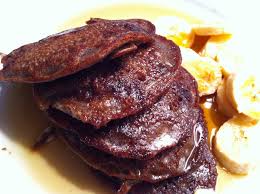 Chocolate chip buckwheat pancakes happily straddled the line between sweet and savory; nutty buckwheat perfectly complemented the chocolate chips. If you’re looking to kick up your pancake game a notch, these would certainly do the trick. They reheated well, too. On the more savory side, sour cream and flaky cheddar biscuits were a definite keeper. They were a bit of work (“lots of cutting-in with the cheese and the butter”) but were flaky as advertised, with a nice umami note from onion powder (“only a quarter teaspoon– but it added a lot!”). Zucchini cornbread and tomato butter was “very savory” with corn, zucchini and onion (perhaps a bit too much onion; the recipe contained half a cup of scallions!). The tomato butter had a somewhat subdued flavor, but was still a welcome complement to the tender yet hearty bread.
Chocolate chip buckwheat pancakes happily straddled the line between sweet and savory; nutty buckwheat perfectly complemented the chocolate chips. If you’re looking to kick up your pancake game a notch, these would certainly do the trick. They reheated well, too. On the more savory side, sour cream and flaky cheddar biscuits were a definite keeper. They were a bit of work (“lots of cutting-in with the cheese and the butter”) but were flaky as advertised, with a nice umami note from onion powder (“only a quarter teaspoon– but it added a lot!”). Zucchini cornbread and tomato butter was “very savory” with corn, zucchini and onion (perhaps a bit too much onion; the recipe contained half a cup of scallions!). The tomato butter had a somewhat subdued flavor, but was still a welcome complement to the tender yet hearty bread.
 As usual, main dishes were our primary focus. Vegetarians had plenty to choose from; four cooks were inspired to try creamy tomato chickpea masala; the general consensus was that it was solid, if not outstanding. The sauce’s creaminess was a plus; some thought the spicing was much too timid, but for others it was more than sufficient. Simple black bean chili turned out to be a keeper; it was fast and delicious, but “make sure you use the jalapeno!” In a similar flavor vein, swiss chard enchiladas had a tasty filling of chard, beans, and corn. Though it was a bit of work to put together, it made a large panful; and it reheated well. Farro salad with roasted tomatoes was a fine farewell to tomato season; one cook liked it well enough that “I’ve made it several times;” but another wished the recipe had some additional veggies to make it more of a main dish. Two people also tried baked orzo and artichokes, a cheesy combo that was “excellent….but prep takes time.” On the other hand, “it was OK– but I don’t think it’s a keeper.” Take your pick! Three cooks landed on
As usual, main dishes were our primary focus. Vegetarians had plenty to choose from; four cooks were inspired to try creamy tomato chickpea masala; the general consensus was that it was solid, if not outstanding. The sauce’s creaminess was a plus; some thought the spicing was much too timid, but for others it was more than sufficient. Simple black bean chili turned out to be a keeper; it was fast and delicious, but “make sure you use the jalapeno!” In a similar flavor vein, swiss chard enchiladas had a tasty filling of chard, beans, and corn. Though it was a bit of work to put together, it made a large panful; and it reheated well. Farro salad with roasted tomatoes was a fine farewell to tomato season; one cook liked it well enough that “I’ve made it several times;” but another wished the recipe had some additional veggies to make it more of a main dish. Two people also tried baked orzo and artichokes, a cheesy combo that was “excellent….but prep takes time.” On the other hand, “it was OK– but I don’t think it’s a keeper.” Take your pick! Three cooks landed on 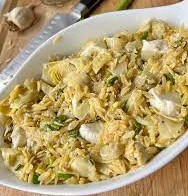 tangy baked eggplant and couscous (that end of summer thing again) which was “OK” though it had “good flavor.” All three wished the dish had a higher eggplant/couscous ratio; the photo shows mostly eggplant but IRL that wasn’t how it played out. Though slow-simmered lentils with kale and goat cheese “didn’t look pretty ” (lentils clearly need a color makeover), this was a “pretty easy” dish that “I liked a lot.” Wine vinegar provided just the right accent, and the whole was “a keeper!” In the cheesy department, deepest dish broccoli cheddar quiche was a quiche of epic proportions; it was tasty but had a few negatives: the crust dough was dry and needed much more water than what the recipe called for, and after baking the crust was soggy as no par- or pre-baking was called for. Also because the quiche was so massive it required two hours to bake! Save this one for when you’re feeding a crowd. Another crust was much more successful: the crust for
tangy baked eggplant and couscous (that end of summer thing again) which was “OK” though it had “good flavor.” All three wished the dish had a higher eggplant/couscous ratio; the photo shows mostly eggplant but IRL that wasn’t how it played out. Though slow-simmered lentils with kale and goat cheese “didn’t look pretty ” (lentils clearly need a color makeover), this was a “pretty easy” dish that “I liked a lot.” Wine vinegar provided just the right accent, and the whole was “a keeper!” In the cheesy department, deepest dish broccoli cheddar quiche was a quiche of epic proportions; it was tasty but had a few negatives: the crust dough was dry and needed much more water than what the recipe called for, and after baking the crust was soggy as no par- or pre-baking was called for. Also because the quiche was so massive it required two hours to bake! Save this one for when you’re feeding a crowd. Another crust was much more successful: the crust for  leek and brie galette was easy to make and just super; tender and flaky as advertised. It went well with the rich brie, but the baked leeks “weren’t my favorite– they tasted too grassy somehow.” But that crust is a keeper! We made a few veggie dishes that could double as sides: skillet white beans caesar were “excellent!” Anchovies added a hit of umami. Pea, feta, and mint fritters were a novel way to use a bag of frozen peas; these crispy fritters were “good…easy…different.” A bit more feta would have been welcome, though the lemony yogurt sauce was a tasty compensation. And charred salt and vinegar cabbage was either “good” or “bland and boring,” depending on who you talked to. The “crispy bits” were the best part, but overall the dish “needed something.”
leek and brie galette was easy to make and just super; tender and flaky as advertised. It went well with the rich brie, but the baked leeks “weren’t my favorite– they tasted too grassy somehow.” But that crust is a keeper! We made a few veggie dishes that could double as sides: skillet white beans caesar were “excellent!” Anchovies added a hit of umami. Pea, feta, and mint fritters were a novel way to use a bag of frozen peas; these crispy fritters were “good…easy…different.” A bit more feta would have been welcome, though the lemony yogurt sauce was a tasty compensation. And charred salt and vinegar cabbage was either “good” or “bland and boring,” depending on who you talked to. The “crispy bits” were the best part, but overall the dish “needed something.”
Phew! And that’s only the vegetarian dishes! One quirk of this title is that there are no fish recipes. We can only assume the author isn’t fond of our finned friends, but it was certainly an oddity for a modern cookbook. There is one shrimp dish, crispy chili garlic butter shrimp. This was a pretty standard, classic combination, although delicious. You can’t go wrong with butter, garlic, and hot pepper; and this is probably also one of the speediest recipes in the book, since shrimp cook in a flash. There were lots of chicken recipes: chicken with rice, chorizo, and tomatoes was loaded with flavor from chorizo, onions, and smoked paprika. It made a lot and reheated beautifully. A keeper!  Weeknight lemon chicken wings took an hour to cook– much longer than the recipe stated. They were good, though “they would be better on the grill.” The buttery mustard sauce balanced the lemon well. Almost a keeper! Turkey meatloaf for skeptics still left us a bit skeptical; it was “OK….it needed something.” Perhaps a meatloaf is always just a meatloaf? Skillet chicken parmesan was a more successful riff on a classic; it was “very good,” though, as is true for many (if not most) casseroles, it was “a bit labor-intensive.” Three cooks were intrigued by
Weeknight lemon chicken wings took an hour to cook– much longer than the recipe stated. They were good, though “they would be better on the grill.” The buttery mustard sauce balanced the lemon well. Almost a keeper! Turkey meatloaf for skeptics still left us a bit skeptical; it was “OK….it needed something.” Perhaps a meatloaf is always just a meatloaf? Skillet chicken parmesan was a more successful riff on a classic; it was “very good,” though, as is true for many (if not most) casseroles, it was “a bit labor-intensive.” Three cooks were intrigued by  fettucine with white ragu; and there were three very different opinions on the result. One person’s take was “boring;” for her the sauce just wasn’t a sauce and needed more liquid to bring it all together. On the other hand, it was a keeper for another cook who enjoyed the somewhat novel taste of pork cooked in milk. The third person was on the fence, liking the flavor but also thinking it needed more of a “real” sauce. Since the weather was cooling off a bit, we made a couple of soups: ginger garlic chicken noodle soup had “nice flavor” and was “probably a keeper.” The photo was absolutely drool-worthy! Winter squash soup with red onion crisp was also a hit; the crispy onion topper really elevated this fall classic.
fettucine with white ragu; and there were three very different opinions on the result. One person’s take was “boring;” for her the sauce just wasn’t a sauce and needed more liquid to bring it all together. On the other hand, it was a keeper for another cook who enjoyed the somewhat novel taste of pork cooked in milk. The third person was on the fence, liking the flavor but also thinking it needed more of a “real” sauce. Since the weather was cooling off a bit, we made a couple of soups: ginger garlic chicken noodle soup had “nice flavor” and was “probably a keeper.” The photo was absolutely drool-worthy! Winter squash soup with red onion crisp was also a hit; the crispy onion topper really elevated this fall classic.
 Moving on to the sweets department, both chocolate peanut butter cup cookies and thick molasses spice cookies were keepers. The spice cookies featured plenty of ginger and were soft and chewy without being cakey. They kept well, too. The chocolate cookies were “fun to make” and were of course “the perfect combo….yum!” On the downside, oatmeal date shortbread came out “greasy, stodgy….only crisp the first day.” Two people loved
Moving on to the sweets department, both chocolate peanut butter cup cookies and thick molasses spice cookies were keepers. The spice cookies featured plenty of ginger and were soft and chewy without being cakey. They kept well, too. The chocolate cookies were “fun to make” and were of course “the perfect combo….yum!” On the downside, oatmeal date shortbread came out “greasy, stodgy….only crisp the first day.” Two people loved  whole lemon poppyseed cake; this easy treat had a good, strong lemon flavor and was not too sweet. One unique feature of this recipe: you use all of the (pureed) lemon in the cake, so you need a fairly heavy-duty blender or food processor. The author’s effort to make this a one-bowl cake resulted in some strange and convoluted instructions. If you’re willing to wash one more bowl, you can simplify prep tremendously. Should you be lucky enough to have a stash of raspberries somewhere, you could try raspberry crostata, which, though “it didn’t look like the photo” (uncooperative crust!) was “delicious!” And, last but not least, chocolate olive oil spread was a sumptuous smooth spread with wonderful dark chocolate flavor. This was very quick and easy to make whenever the chocolate urge strikes. A keeper!
whole lemon poppyseed cake; this easy treat had a good, strong lemon flavor and was not too sweet. One unique feature of this recipe: you use all of the (pureed) lemon in the cake, so you need a fairly heavy-duty blender or food processor. The author’s effort to make this a one-bowl cake resulted in some strange and convoluted instructions. If you’re willing to wash one more bowl, you can simplify prep tremendously. Should you be lucky enough to have a stash of raspberries somewhere, you could try raspberry crostata, which, though “it didn’t look like the photo” (uncooperative crust!) was “delicious!” And, last but not least, chocolate olive oil spread was a sumptuous smooth spread with wonderful dark chocolate flavor. This was very quick and easy to make whenever the chocolate urge strikes. A keeper!
Anyone reading this far would have to agree that we gave this book a thorough review. We found most of the recipes to be approachable, though some took a bit more doing than we might have liked. Generally, we weren’t crazy about her instructions– a few people mentioned that they seemed unnecessarily complicated or obtuse. This wasn’t a dealbreaker, but it was noticeable. And though all of us found at least one keeper in this book, overall it didn’t reach the level we might have hoped. But, as noted above, a keeper is personal, and the author’s vision of a keeper just may not be ours. So, in the final analysis, our rating averaged out to a 3.3 (out of a possible 5). As is often the case, that average-ish rating disguises strong high and low ratings. So, you’ll just have to take out the book yourself and decide!
Please join us for our next meeting on Friday October 27 at 11 AM in the Fireplace Room. We’ll be discussing everyone’s favorite fall fruit with Amy Traverso’s The Apple Lover’s Cookbook. Copies are available at the main circulation desk or via curbside pickup. See you there!

Bibliobites Extra: Survey Says…..!
 Our Bibliobites group enjoys a survey as much as anyone else. In fact, that’s pretty much what we do every month– we (thoroughly!) survey a cookbook by reading it and cooking our way through it; then we discuss our results and render a verdict. So, before we begin a new session in September, let’s take a brief look back at where we’ve been.
Our Bibliobites group enjoys a survey as much as anyone else. In fact, that’s pretty much what we do every month– we (thoroughly!) survey a cookbook by reading it and cooking our way through it; then we discuss our results and render a verdict. So, before we begin a new session in September, let’s take a brief look back at where we’ve been.
I asked group members to send me their top “keepers” from 2022-2023. For us, these are the best of the best: the ones that have made it into our regular rotations, the ones we get excited about eating the minute we pull out the recipe. Check them out! They could become your favorites, too.
 Unsurprisingly, our top-rated book of the year (4.4 out of a possible 5), Once Upon a Chef Weeknight/Weekend by Jennifer Segal, generated several keepers. Among the many highlights were smoky chickpea, red lentil, and vegetable soup (“hearty with lots of smoky flavor….super!”), drunken style noodles with shrimp (“I want to go back to this one!”), bbq soy and ginger chicken thighs (“super on the grill!”), ciabatta pesto pizza (“a go-to for a quick supper”), pan-seared halibut (“the sauce makes the dish…very rich…easy”), and, for dessert, french apple cake (“the rum is perfect…a nice small cake”) and brownie pudding (“rich and buttery, yet light and delicate!”). It’s worth noting that most of the above recipes were highly praised by multiple people.
Unsurprisingly, our top-rated book of the year (4.4 out of a possible 5), Once Upon a Chef Weeknight/Weekend by Jennifer Segal, generated several keepers. Among the many highlights were smoky chickpea, red lentil, and vegetable soup (“hearty with lots of smoky flavor….super!”), drunken style noodles with shrimp (“I want to go back to this one!”), bbq soy and ginger chicken thighs (“super on the grill!”), ciabatta pesto pizza (“a go-to for a quick supper”), pan-seared halibut (“the sauce makes the dish…very rich…easy”), and, for dessert, french apple cake (“the rum is perfect…a nice small cake”) and brownie pudding (“rich and buttery, yet light and delicate!”). It’s worth noting that most of the above recipes were highly praised by multiple people.
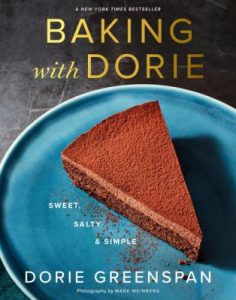 Despite the fact that several in our group are avowed non-bakers, Dorie Greenspan’s Baking With Dorie was our second highest-rated title of the year (3.77 out of a possible 5). After many decades in the cookbook biz, it’s apparent that the author knows her way around a cookie sheet, and a recipe! Our keepers from this book included mocha walnut torte (“dairy free and gluten free so great for those with food restrictions”), olive oil brownies (“excellent fudginess!”), grain and seed muffins (“really delicious…not too sweet”), and bakewell tart (“tender almond sponge cake, raspberry jam, pastry crust….hit all the right notes for me!”).
Despite the fact that several in our group are avowed non-bakers, Dorie Greenspan’s Baking With Dorie was our second highest-rated title of the year (3.77 out of a possible 5). After many decades in the cookbook biz, it’s apparent that the author knows her way around a cookie sheet, and a recipe! Our keepers from this book included mocha walnut torte (“dairy free and gluten free so great for those with food restrictions”), olive oil brownies (“excellent fudginess!”), grain and seed muffins (“really delicious…not too sweet”), and bakewell tart (“tender almond sponge cake, raspberry jam, pastry crust….hit all the right notes for me!”).
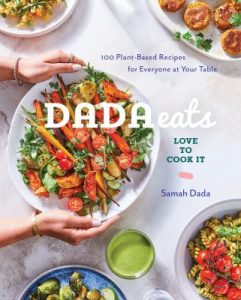 Even titles that generated a lukewarm response overall could surprise us with flashes of brilliance. Dada Eats Love to Cook It by Samah Dada, while squarely in “meh” territory (2.9 out of a possible 5) had us falling in intense legume love with chana masala, dal makhani, and the best dal ever.
Even titles that generated a lukewarm response overall could surprise us with flashes of brilliance. Dada Eats Love to Cook It by Samah Dada, while squarely in “meh” territory (2.9 out of a possible 5) had us falling in intense legume love with chana masala, dal makhani, and the best dal ever.  Jew-ish by Jake Cohen also garnered a very average rating (3.0 out of 5), but our cooks were passionate about a few recipes: pomegranate bbq chicken wings (“one of the best wing sauces ever!”) and iraqi roasted salmon (“awesome tomato-lemon topper– perfect with the salmon!”). Moving a bit further down the ratings, Grains For Every Season by Joshua McFadden (2.75 out of 5) also had a couple of well-loved dishes: both farrotto in the style of cacio e pepe (“enjoyed this more than a rice risotto…nice flavor!”) and buckwheat cream scones your way (“rich yet light with delicate buckwheat flavor”)are on repeat, or will be when the weather cools off a bit!
Jew-ish by Jake Cohen also garnered a very average rating (3.0 out of 5), but our cooks were passionate about a few recipes: pomegranate bbq chicken wings (“one of the best wing sauces ever!”) and iraqi roasted salmon (“awesome tomato-lemon topper– perfect with the salmon!”). Moving a bit further down the ratings, Grains For Every Season by Joshua McFadden (2.75 out of 5) also had a couple of well-loved dishes: both farrotto in the style of cacio e pepe (“enjoyed this more than a rice risotto…nice flavor!”) and buckwheat cream scones your way (“rich yet light with delicate buckwheat flavor”)are on repeat, or will be when the weather cools off a bit!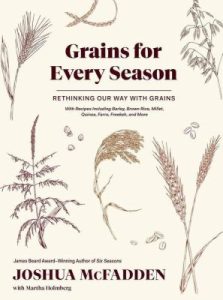
As always, there were titles that just didn’t speak to us, even if they’d been well reviewed by those who probably know way more about food and cooking than we do. However, in our defense, we actually make the recipes in a book, not just read them and drool over the photos. Sometimes dishes that sounded wonderful on the page wound up needing more time, pots, bowls, or expensive ingredients than we anticipated. Some dishes didn’t taste as described, or as good as we’d expected. But even titles we didn’t enjoy all that much had their moments. One Pot, Pan, Planet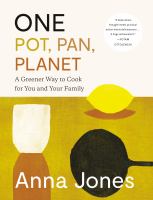 by Anna Jones (2.3 out of 5) had a “sleeper hit” with quick squash lasagna. Stir by Barbara Lynch (2.5 out of 5) had old fellow marinara sauce, “the one recipe I have used the most this year.” And from In Cod We Trust by Heather Atwood (1.9 out of 5) two cooks raved about roasted cherry tomato sauce, a zippy relish that keeps well and tastes fantastic on almost anything.
by Anna Jones (2.3 out of 5) had a “sleeper hit” with quick squash lasagna. Stir by Barbara Lynch (2.5 out of 5) had old fellow marinara sauce, “the one recipe I have used the most this year.” And from In Cod We Trust by Heather Atwood (1.9 out of 5) two cooks raved about roasted cherry tomato sauce, a zippy relish that keeps well and tastes fantastic on almost anything.
For all you numbers people out there, this year’s highest rating was a 4.4, and the lowest a 1.9. Our combined average for all titles was 3.05. That’s very…..average! Check out any or all of the above titles and see if you agree with our group’s opinions. And please join us at our next meeting, Friday September 29 at 11 AM in the Fireplace Room. Speaking of keepers, we’ll be road-testing Deb Perelman’s newest, Smitten Kitchen Keepers. Copies are available at the main circulation desk or via curbside pickup. See you then!





